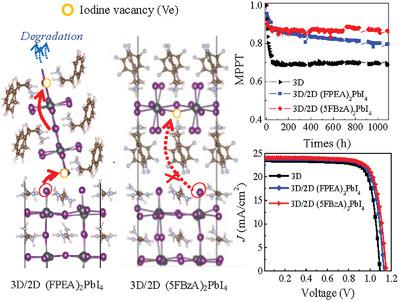Our official English website, www.x-mol.net, welcomes your
feedback! (Note: you will need to create a separate account there.)
Molecular Design and Operational Stability: Toward Stable 3D/2D Perovskite Interlayers
Advanced Science ( IF 14.3 ) Pub Date : 2020-08-16 , DOI: 10.1002/advs.202001014 Sanghyun Paek 1, 2 , Cristina Roldán-Carmona 1 , Kyung Taek Cho 1, 3 , Marius Franckevičius 4 , Hobeom Kim 1 , Hiroyuke Kanda 1 , Nikita Drigo 1 , Kun-Han Lin 5 , Mingyuan Pei 6 , Rokas Gegevičius 4 , Hyung Joong Yun 7 , Hoichang Yang 6 , Pascal A Schouwink 8 , Clémence Corminboeuf 5 , Abdullah M Asiri 9 , Mohammad Khaja Nazeeruddin 1
Advanced Science ( IF 14.3 ) Pub Date : 2020-08-16 , DOI: 10.1002/advs.202001014 Sanghyun Paek 1, 2 , Cristina Roldán-Carmona 1 , Kyung Taek Cho 1, 3 , Marius Franckevičius 4 , Hobeom Kim 1 , Hiroyuke Kanda 1 , Nikita Drigo 1 , Kun-Han Lin 5 , Mingyuan Pei 6 , Rokas Gegevičius 4 , Hyung Joong Yun 7 , Hoichang Yang 6 , Pascal A Schouwink 8 , Clémence Corminboeuf 5 , Abdullah M Asiri 9 , Mohammad Khaja Nazeeruddin 1
Affiliation

|
Despite organic/inorganic lead halide perovskite solar cells becoming one of the most promising next‐generation photovoltaic materials, instability under heat and light soaking remains unsolved. In this work, a highly hydrophobic cation, perfluorobenzylammonium iodide (5FBzAI), is designed and a 2D perovskite with reinforced intermolecular interactions is engineered, providing improved passivation at the interface that reduces charge recombination and enhances cell stability compared with benchmark 2D systems. Motivated by the strong halogen bond interaction, (5FBzAI)2PbI4 used as a capping layer aligns in in‐plane crystal orientation, inducing a reproducible increase of ≈60 mV in the Voc, a twofold improvement compared with its analogous monofluorinated phenylethylammonium iodide (PEAI) recently reported. This endows the system with high power conversion efficiency of 21.65% and extended operational stability after 1100 h of continuous illumination, outlining directions for future work.
中文翻译:

分子设计和操作稳定性:迈向稳定的 3D/2D 钙钛矿中间层
尽管有机/无机卤化铅钙钛矿太阳能电池成为最有前途的下一代光伏材料之一,但热和光浸泡下的不稳定性仍未解决。在这项工作中,设计了一种高度疏水的阳离子全氟苄基碘化铵(5FBzAI),并设计了一种具有增强分子间相互作用的二维钙钛矿,与基准二维系统相比,改善了界面的钝化,减少了电荷重组并增强了电池稳定性。在强卤素键相互作用的推动下,用作覆盖层的 (5FBzAI) 2 PbI 4在面内晶体方向上排列,导致V oc可重复增加约 60 mV,与类似的单氟化苯乙基碘化铵相比,提高了一倍(PEAI)最近报道。这使得该系统具有21.65%的高功率转换效率,并在连续照明1100小时后延长了运行稳定性,为未来的工作指明了方向。
更新日期:2020-10-07
中文翻译:

分子设计和操作稳定性:迈向稳定的 3D/2D 钙钛矿中间层
尽管有机/无机卤化铅钙钛矿太阳能电池成为最有前途的下一代光伏材料之一,但热和光浸泡下的不稳定性仍未解决。在这项工作中,设计了一种高度疏水的阳离子全氟苄基碘化铵(5FBzAI),并设计了一种具有增强分子间相互作用的二维钙钛矿,与基准二维系统相比,改善了界面的钝化,减少了电荷重组并增强了电池稳定性。在强卤素键相互作用的推动下,用作覆盖层的 (5FBzAI) 2 PbI 4在面内晶体方向上排列,导致V oc可重复增加约 60 mV,与类似的单氟化苯乙基碘化铵相比,提高了一倍(PEAI)最近报道。这使得该系统具有21.65%的高功率转换效率,并在连续照明1100小时后延长了运行稳定性,为未来的工作指明了方向。











































 京公网安备 11010802027423号
京公网安备 11010802027423号